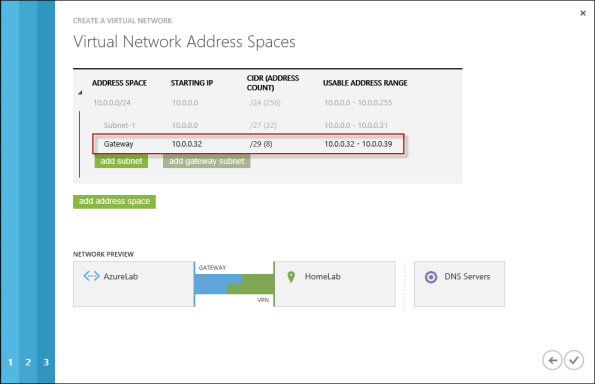Archive
Enable TLS Forward Secrecy for Forefront TMG 2010 Published Web Sites
Last year I wrote an article for ISAserver.org that outlined in detail how to improve SSL and TLS security for web sites published using Forefront TMG 2010. In its default configuration, Windows Server 2008 R2 and Forefront TMG leave quite a bit to be desired in terms of SSL and TLS security. In the article I demonstrated how to dramatically improve the security posture of TMG when publishing web sites that use SSL and TLS. At the time I wrote the article it was not recommended to enable forward secrecy, so the changes I originally proposed resulted in an “A” score from the Qualys SSL Labs test site. However, times have changed since then, and with the recent revelations of wide spread government spying, it is now recommended to enable forward secrecy by default. Sites that don’t support forward secrecy will now receive a reduced grade.

To accomplish this on the Forefront TMG 2010 firewall, open the Local Group Policy Editor (gpedit.msc) and navigate to Computer Configuration, Administrative Templates, Network, SSL Configuration Settings. Double-click SSL Cipher Suite Order and choose Enabled. Copy the list of SSL cipher suites to a blank notepad document and then move all of the cipher suites that begin with TLS_ECDHE_RSA_WITH_AES_ to the front of the list. Use caution here because the list cannot have any extra commas, line breaks, or spaces at all. Paste the updated list back in to the SSL Cipher Suites box and click Ok.

The server will have to be restarted for the changes to take effect. Once complete, forward secrecy will now be used by modern browsers and you should once again receive an “A” grade from SSL Labs.

Hotfix Rollup 5 for Forefront TMG 2010 SP2 Now Available
Hotfix rollup 5 for Microsoft Forefront TMG 2010 with Service pack 2 (SP2) is now available for download. This latest hotfix rollup includes fixes for the following issues:
KB2963805 – Account lockout alerts are not logged after you install Rollup 4 for Forefront TMG 2010 SP2
KB2963811 – The Forefront TMG 2010 Firewall service (wspsrv.exe) may crash when the DiffServ filter is enabled
KB2963823 – “1413 Invalid Index” after you enable cookie sharing across array members in Forefront TMG 2010
KB2963834 – HTTPS traffic may not be inspected when a user accesses a site through Forefront TMG 2010
KB2967726 – New connections are not accepted on a specific web proxy or web listener in Forefront TMG 2010
KB2965004 – EnableSharedCookie option doesn’t work if the Forefront TMG 2010 service runs under a specific account
KB2932469 – An incorrect value is used for IPsec Main Mode key lifetime in Threat Management Gateway 2010
KB2966284 – A zero value is always returned when an average counter of the “Forefront TMG Web Proxy” object is queried from the .NET Framework
KB2967763 – The “Const SE_VPS_VALUE = 2” setting does not work for users if the UPN is not associated with a real domain
KB2973749 – HTTP Connectivity Verifiers return unexpected failures in TMG 2010
You can download hotfix rollup 5 for Forefront TMG 2010 SP2 here. After applying this update, the new Forefront TMG 2010 build number will be 7.0.9193.644.
Forefront TMG 2010 Computer Certificate Request or Renewal Fails
When attempting to request or renew a computer certificate on the Forefront TMG 2010 firewall, you may receive the following error message:
Status: Failed The RPC server is unavailable.

This occurs because the Forefront TMG 2010 firewall does not, by default, allow the protocols and ports required to request or renew a certificate from a Certificate Authority (CA). Common workarounds suggest stopping the firewall completely or creating a rule allowing all protocols and ports from the TMG firewall to the CA. However, both of these workarounds are problematic. Stopping the firewall is a manual process that will cause a service disruption. It also leaves the firewall in an unprotected state. For edge deployment scenarios, the underlying operating system will be exposed directly to untrusted networks, which is a serious security risk. Creating an open access rule is not desirable because it violates the basic security principle of least privilege by allowing more access than is required.
To properly address this issue and allow for the secure request and renewal of certificates without disruption and with the least exposure, it will be necessary to create an access rule on the Forefront TMG 2010 firewall to allow all dynamic ports (TCP 49152-65535) from the local host network to the IP address of the CA for all users.
Note: Allowing all dynamic ports (TCP 49152-65535) might also be considered too much access from the Forefront TMG 2010 firewall to the CA. It is possible to restrict the dynamic ports used by TMG and further tighten the access rule, if required. For information about restricting dynamic ports, click here.
In addition to the access rule allowing all dynamic ports, it will also be necessary to make a change to a system policy rule. To do this, right-click the Firewall Policy node in the navigation tree and choose All Tasks, System Policy, and then Edit System Policy. In the Authentication Services group highlight Active Directory and clear the checkbox next to Enforce strict RPC compliance.

Once these changes have been made you can now request or renew a computer certificate on the Forefront TMG 2010 firewall successfully.

Windows Azure Multifactor Authentication and Forefront TMG 2010
When Microsoft first announced Windows Azure Multi-Factor Authentication, a cloud-based strong authentication solution, my first thought was “I wonder if it works with Forefront TMG 2010?” Being cloud-based, my first thought was perhaps not. However, once I started digging in to it I quickly learned that it includes a software component that can be installed on-premises and will even integrate with on-premises security solutions via a number of interfaces, including RADIUS. Forefront TMG 2010 has supported RADIUS authentication for many years, so I put together a test lab and in no time at all I had Windows Azure multi-factor authentication working with Forefront TMG 2010 remote access VPN. Forefront TMG 2010 integrated with Windows Azure multi-factor authentication provides the highest level of protection for remote access users. Leveraging Windows Azure cloud-based strong authentication is extremely cost effective, with very low per user or per authentication costs and no on-premises hardware to purchase. The Windows Azure public cloud, which is ISO/IEC27001:2005 certified, provides the most secure and reliable strong authentication service available today. To learn how to configure Forefront TMG 2010 to work with Windows Azure multi-factor authentication, click here.
Hotfix Rollup 4 for Forefront TMG 2010 SP2 Now Available
Hotfix rollup 4 for Microsoft Forefront TMG 2010 with Service Pack 2 (SP2) is now available for download. This latest hotfix rollup includes fixes for the following issues:
KB2889345 – Accounts are locked out beyond the AccountLockoutResetTime period in Forefront TMG 2010 SP2
KB2890549 – Incorrect Performance Monitor values when queried from a .NET Framework app in Forefront TMG 2010
KB2890563 – “URL” and “Destination Host Name” values are unreadable in the web proxy log of Forefront TMG 2010
KB2891026 – Firewall Service leaks memory if Malware Inspection is enabled in Forefront TMG 2010
KB2888619 – A password change is unsuccessful if a user’s DN attribute contains a forward slash and an Active Directory LDAP-defined special character in Forefront TMG 2010
KB2863383 – “Query stopped because an error occurred while it was running” when you run a non-live query in Forefront TMG 2010 SP2
KB2899720 – Threat Management Gateway 2010 incorrectly sends “Keep-Alive” headers when it replies to Media Player WPAD file requests
KB2899716 – Firewall service (Wspsrv.exe) crashes when a web publishing request is handled in Forefront TMG 2010
KB2899713 – Access to certain SSL websites may be unavailable when HTTPS Inspection is enabled in Forefront Threat Management Gateway 2010
You can download hotfix rollup 4 for Forefront TMG 2010 SP2 here. After applying this update, the new Forefront TMG 2010 build number will be 7.0.9193.601.
Publishing Exchange 2013 Outlook Web App with Forefront TMG 2010
Recently I wrote an article for ISAserver.org about publishing Exchange 2013 Outlook Web App (OWA) using Forefront TMG 2010. In spite of the fact that many organizations are migrating their e-mail services to the cloud, there are many organizations who cannot, for a variety of reasons, take advantage of cloud services for e-mail. This makes Exchange 2013 a compelling upgrade for many companies. Historically Forefront TMG 2010 and its predecessors were the go-to service for securing access to on-premises Exchange implementations. Forefront TMG 2010 supports OWA publishing with native publishing wizards, allowing you to select which version of Exchange you are publishing, with the added bonus of providing in-box forms-based authentication (FBA) templates that matched the look and feel of the Exchange version you were publishing. Since Forefront TMG 2010 has been deprecated, Microsoft has not updated Forefront TMG 2010 to include support for Exchange 2013 OWA. However, you can still publish Exchange 2013 OWA using Forefront TMG by following the instructions outlined in my ISAserver.org post. When using this method, the Exchange 2010 FBA templates are used. This makes the user experience somewhat disjointed, with the FBA pages not matching the new, updated look and feel of OWA 2013. To remedy this, I reached out to my good friend Scott Glew at Fastvue. Scott is a terrific web developer, as evidenced by the amazing UI included with the TMG Reporter solution. In short order, Scott whipped up some customized Forefront TMG 2010 FBA templates to match the look and feel of OWA 2013 and has made them available for free. Now if you’re publishing Exchange 2013 OWA using Forefront TMG 2010, you can download these custom templates and use them to provide a consistent experience for your Exchange OWA users. Enjoy!
Improving SSL Security for Forefront TMG 2010 Published Web Sites
Recently I wrote an article for ISAserver.org entitled Improving SSL Security for Forefront TMG 2010 Published Web Sites. In the article I demonstrate how to evaluate the current security configuration of your Forefront TMG firewall for published SSL web sites and how to make changes to the default settings in order to improve the overall security posture of TMG in reverse proxy scenarios. Implementing these changes will provide dramatically improved protection for Forefront TMG published SSL web sites. The steps outlined in the article include details for changes to be made to specific registry entries on the Forefront TMG 2010 firewall. I’ve had a number of requests to make the registry file available for download in order to simplify the process and ensure that these changes are made correctly. You can download the registry file used in the ISAserver.org post here. Enjoy!
Extending the Life of Forefront TMG 2010 with Zscaler Cloud Based Security
Forefront TMG End of Life
With the end of life announcement for Microsoft Forefront TMG 2010, one of the most common questions I am asked is “What should I replace my Forefront TMG firewall with?” Many are surprised when I reply “Why do you want to replace it?” Simply because Forefront TMG will not be developed in the future does not mean there’s an immediate need to replace it. Considering the fact that Forefront TMG mainstream support extends until April 2015, and extended support lasts until April 2020, often the decision to replace TMG is nothing more than a knee-jerk reaction to marketing pressure by vendors of competing solutions.
Do You Need to Replace Forefront TMG 2010 Now?
If you have deployed Forefront TMG 2010 as a firewall, basic forward or reverse web proxy, or remote access or site-to-site VPN, there is no need to replace Forefront TMG 2010 right now. All of the features used in these deployment scenarios will continue to function in to perpetuity. You have until April 2020 to find a replacement for Forefront TMG, which should give you plenty of time to consider alternative solutions. However, if you have deployed Forefront TMG as a secure web gateway, the situation is a little different. Although support for the product extends until April 2020, the Web Protection Service (WPS) subscription will only function until the end of 2015. This means that URL filtering reputation database updates, antimalware signatures, and Network Inspection System (NIS) signatures will no longer be updated past this time. Not to worry, there are some excellent cloud-based security solutions that can be integrated with Forefront TMG 2010 to effectively extend the life of TMG for the foreseeable future.
Extending the Life of Forefront TMG 2010 with Zscaler
Recently I had the opportunity to evaluate the Zscaler Cloud-based security solution. Zscaler provides security-as-a-service and integrates seamlessly with Forefront TMG to provide essential web security protection with URL filtering, dynamic web content control, virus and malicious software scanning, HTTPS inspection capabilities, and more. The Zscaler security solution provides significantly more protection than the native Forefront TMG technologies offer. There are also tremendous economies of scale to be gained by using this cloud-based security solution, as Zscaler has more than 4000 enterprise customers in 180 countries, servicing more than 10 million users globally. The threat intelligence gained from having such a broad view of Internet activity worldwide enables Zscaler to quickly identify emerging threats on a global basis and extend protection to all of its customers quickly and effectively.
Zscaler Integration with Forefront TMG 2010
Integrating an on-premises Forefront TMG firewall with the Zscaler cloud is accomplished without having to install a plug-in on the TMG firewall. On-premises web traffic is delivered to the Zscaler cloud service by Forefront TMG through the use of web proxy chaining rules. After you’ve signed up for the service, simply configure a web proxy chaining rule to forward web proxy requests from Forefront TMG to the Zscaler cloud proxy gateways.
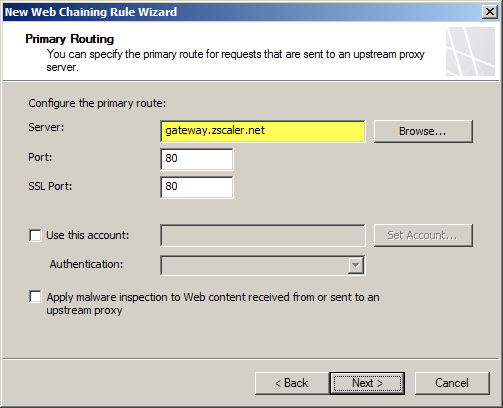

Zscaler Protection for Mobile Users
The Zscaler solution has some additional advantages over Forefront TMG’s native web protection mechanisms. With a cloud-based solution, Zscaler’s protection can also be extended transparently to mobile users, keeping them safe regardless of where they are. Zscaler has more than 100 datacenters worldwide, ensuring quick response times and low latency wherever the mobile user happens to be. Integrating individual clients can be done using proxy PAC files to route traffic to Zscaler’s datacenters. Additionally there is an option to install an agent on the client to forward traffic, which has the benefit of preventing the end user from disabling proxy settings to bypass content filtering restrictions.
Forefront TMG 2010 and Zscaler – Better Together
You may be asking yourself “Why not just use Zscaler exclusively? Why do I need TMG at all?” Valid question! Integrating Zscaler with Forefront TMG provides the best of both worlds in terms of security and performance. With Forefront TMG 2010 on premises, you have a Common Criteria-certified enterprise-class firewall to provide the highest level of security for your network. You can leverage strong user and group-based authentication, and you gain the added benefit of local caching for web content. In addition, you can make use of Forefront TMG 2010’s other features like multi-networking to create perimeter or DMZ networks for isolating public-facing services, reverse proxy for on-premises web-based and non-web based applications and services, remote access VPN for managed and non-managed mobile users, and site-to-site VPN to connect remote offices, business partners, or cloud service providers.
Forefront TMG End of Sale? Not Quite!
Although Microsoft is committed to supporting Forefront TMG 2010 for many years to come, they are no longer selling Forefront TMG 2010 licenses or the Web Protection Service (WPS) subscription licenses. If you’ve already deployed Forefront TMG 2010, or have already purchased Forefront TMG processor licenses and the WPS subscription, you have nothing to worry about. If you’re looking to deploy Forefront TMG 2010 today, you can’t purchase licenses for the software from Microsoft. However, you can still obtain Forefront TMG 2010 through a Microsoft OEM partner like Celestix Networks. (Full disclosure: Celestix Networks is my current employer.)
Keep Calm and Carry On
In my estimation, you can safely deploy or keep Forefront TMG 2010 in your environment and still gain a healthy return on your investment for many years to come. If you’re using Forefront TMG for publishing services such as Outlook Web App (OWA) or SharePoint, or you’re leveraging client-based remote access or site-to-site VPN, you have nothing to worry about. If you’re using Forefront TMG as a secure web gateway, you can enhance and extend the solution by using Zscaler’s cloud-based security solution for less than you would have paid for the Microsoft WPS subscription. No need to go out and replace your Forefront TMG 2010 solution for quite a few more years! If you are considering a new deployment, you can still purchase Forefront TMG 2010 from Microsoft OEM partners like Iron Networks. So Keep Calm and Deploy Forefront TMG 2010 today!
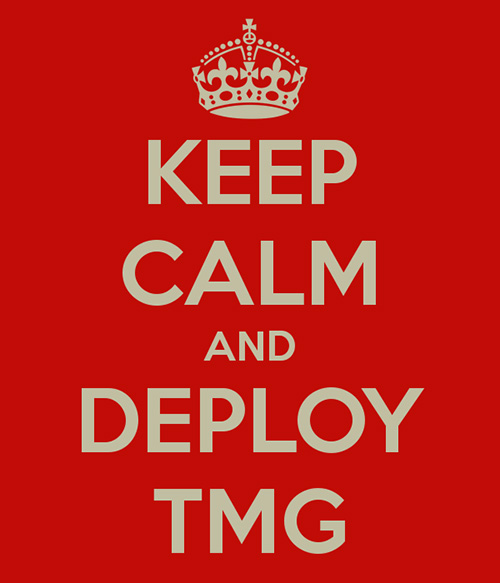
Enable Hybrid Cloud with Forefront TMG 2010 and Windows Azure
Earlier this year I published an article on ISAserver.org on how to enable cross-premises network connectivity to Windows Azure using Forefront TMG 2010. When I wrote that piece, Windows Azure virtual networking was still in preview (beta). Since that time, Windows Azure virtual networking has been officially released, with some significant changes in features, functionality, and configuration steps. Many people noticed that their existing Forefront TMG 2010 to Windows Azure site-to-site VPN stopped working at this time and assumed that support for TMG had been dropped. Not so! Forefront TMG 2010 site-to-site VPN does work with Windows Azure virtual networks, and is indeed supported as it meets the minimum requirements for VPN devices connecting to Windows Azure virtual networks outlined here.
Configuring site-to-site VPN connectivity between the Forefront TMG 2010 firewall and Windows Azure virtual networks is not without a minor drawback, however. One of the new features of Windows Azure virtual networking is point-to-site VPN using SSTP. Unfortunately this feature requires that you configure dynamic routing on your Windows Azure virtual network, and dynamic routing makes use of IKEv2, which the Forefront TMG 2010 firewall does not support. So, if you want to enable cross-premises network connectivity to Windows Azure using Forefront TMG 2010, you will not be able to take advantage of this new point-to-site VPN connectivity option.
Important Note: Windows Azure virtual networking site-to-site VPN requires that your VPN endpoint have a public IPv4 address assigned to it’s external network interface. If your Forefront TMG 2010 firewall is located behind a border router or edge firewall performing NAT, site-to-site VPN connectivity with Windows Azure will not be possible.
To configure cross-premises network connectivity with Windows Azure, log in to the Windows Azure portal and select Networks in the navigation pane, then click on Create Virtual Network. Enter a Name for the virtual network, specify a Region, and provide an Affinity Group Name and select the appropriate Subscription.
Enter the names and IP addresses of any DNS servers to be used by machines in this virtual network and select the option to Configure site-to-site VPN. Do NOT select the option to Configure point-to-site VPN.
Provide a name for the site-to-site connection and enter the IP address assigned to the external network interface of the Forefront TMG firewall. In addition, specify the network address space in use on the private, on-premises side of the connection.
Define your virtual network subnet as required. Here I’ve chosen to use the 10.0.0.0/24 address space. Define any additional subnets as necessary and then click Add gateway subnet.
Click on the newly created virtual network and then click on Dashboard. Click Create Gateway and choose Static Routing.
Once the gateway has been created, make a note of the Gateway IP Address and then click Manage Key. Copy this key as it will be required when configuring the site-to-site VPN on the Forefront TMG 2010 firewall.
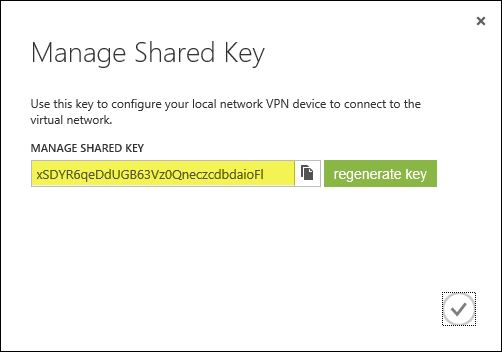
On the Forefront TMG 2010 firewall, open the management console and select Remote Access Policy (VPN). Click the Remote Sites tab in the center pane and then click Create VPN Site-to-Site Connection in the Tasks pane. When the Create Site-to-Site Connection Wizard begins, enter a name for the new site-to-site network.
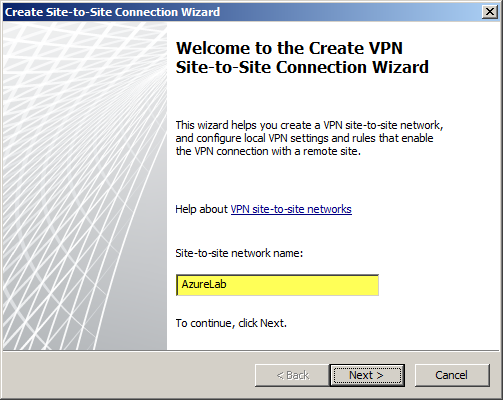
Select IP Security protocol (IPsec) tunnel mode.

Enter the IP address of the Windows Azure virtual network gateway and the local VPN gateway IP address, which is the IP address assigned to the external network interface of the Forefront TMG 2010 firewall.

Copy the pre-shared key from the Windows Azure virtual network gateway.
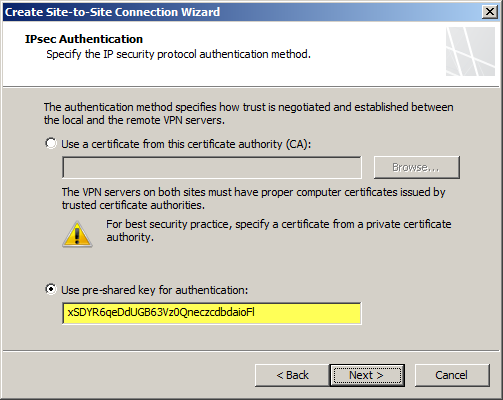
The IP address of the Windows Azure virtual network gateway will be automatically added to the network address list. Click Add Range and add the IP address range you defined earlier for the virtual network.
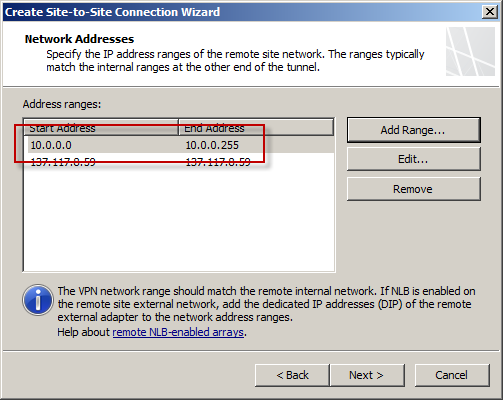
Select the option Create a network rule specifying a route relationship.

Any communication between the on-premises network and the Windows Azure virtual network must be allowed by firewall policy. You can create an access rule now, or create one later.
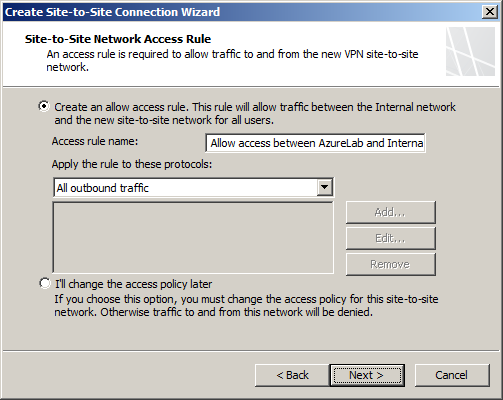
Review the configuration settings and click Finish.

Before applying the configuration, right-click the site-to-site connection and choose Properties, select the Connection tab, and then click IPsec Settings.
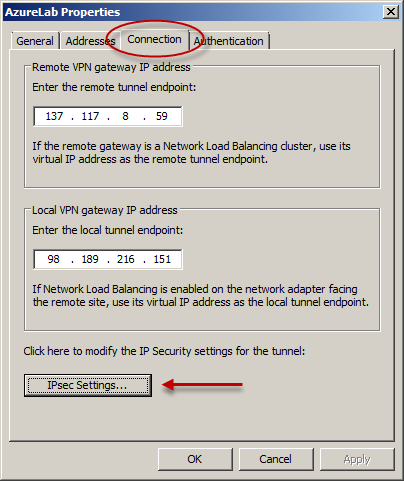
On the Phase I tab select SHA1 for the Integrity algorithm and leave the remaining settings at their defaults.

On the Phase II tab select SHA1 for the Integrity Algorithm. Select the option to Generate a new key every 102400000 Kbytes and clear the option to Use Perfect Forward Secrecy (PFS).
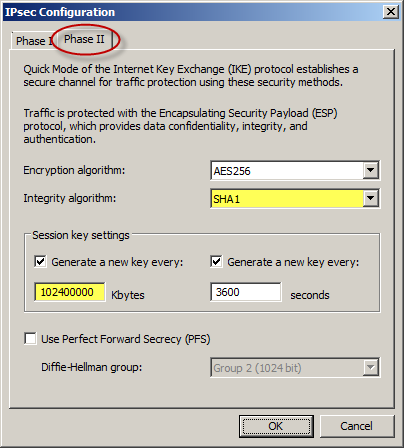
Once complete, apply the configuration. Finally, set the Maximum Transmission Unit (MTU) on the Forefront TMG 2010 firewall’s external interface to 1350 bytes by opening an elevated command prompt and issuing the following command:
netsh interface ipv4 set interface <interface_name_or_index> mtu=1350
For example:
netsh interface ipv4 set interface external mtu=1350
The Windows Azure management console should now indicate that you have successfully established a site-to-site VPN to the remote virtual network.
When you configure a new Windows Azure virtual machine, you can specify that the machine be placed in to your virtual network.
The new virtual machine should now be reachable from your on-premises network using the site-to-site VPN configured on the Forefront TMG 2010 firewall.
Citrix NetScaler Forefront TMG 2010 Replacement White Paper
With the formal end of life announcement for Forefront TMG 2010 last year, many firewall and secure web gateway vendors have been touting themselves as replacements for TMG. The folks at Citrix recently made available a white paper [PDF] making their case as a comprehensive replacement for Forefront TMG. While I don’t have any personal experience with the NetScaler solution, it does appear to have many of the features that TMG administrators have come to rely upon, such as URL filtering, virus and malicious software inspection, SSL termination (HTTPS inspection), content caching, low-level intrusion detection and prevention, and VPN capabilities. In addition, the NetScaler supports flexible network placement with edge, back firewall, and unihomed (single-legged or one-arm) deployment options. The solution is available in both hardware appliance form factor and virtual appliance.
Citrix makes an attempt to position their solution as the ideal and comprehensive replacement for Forefront TMG, and while it does have many features that TMG provides there is one glaring omission – an alternative to the Forefront TMG Firewall Client. ISA and TMG administrators have long used the Firewall Client to provide seamless and transparent proxy services for Winsock applications. The firewall client enables fully authenticated proxy support for non-web based protocols, and it appears that the NetScaler does not include such capabilities.
As with most white papers comparing solutions like this, it is helpful to understand they are essentially marketing material designed to downplay the features of the competing solution while often embellishing their own features. There are also some inaccuracies with regard to Forefront TMG capabilities, which is also not uncommon in documents such as these. For example, the document states that Forefront TMG 2010 failover requires three nodes, which is incorrect. You can easily create a standalone array using Forefront TMG 2010 Enterprise Edition using two nodes.
Overall the Citrix NetScaler looks like a pretty good solution. If you are in the market today for an alternative to Forefront TMG 2010 (…and should you be? That’s a topic for a future post, so stay tuned!) then download their white paper and take a closer look.







